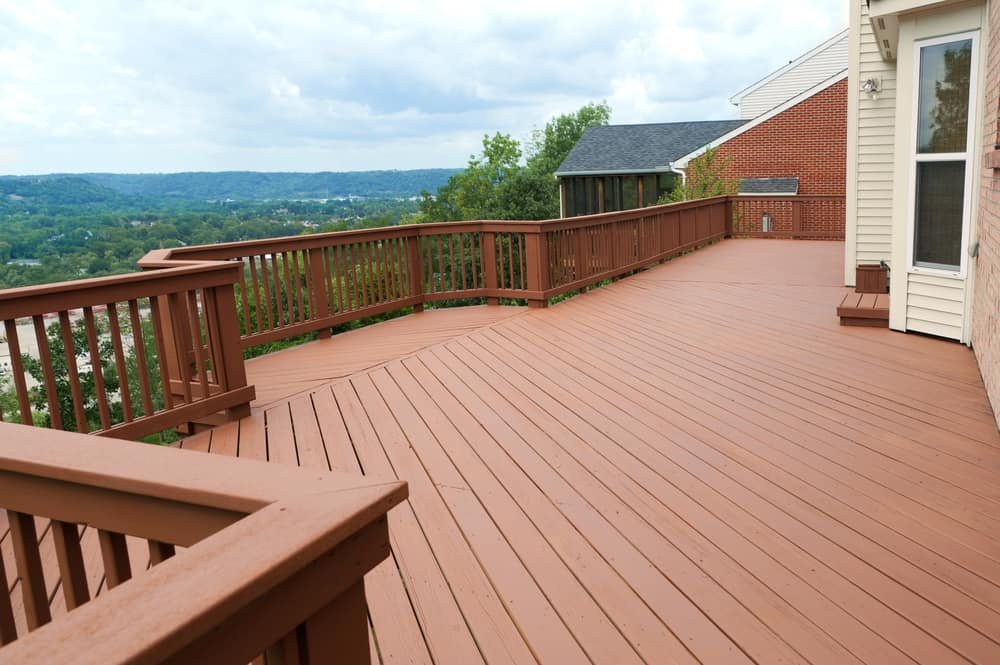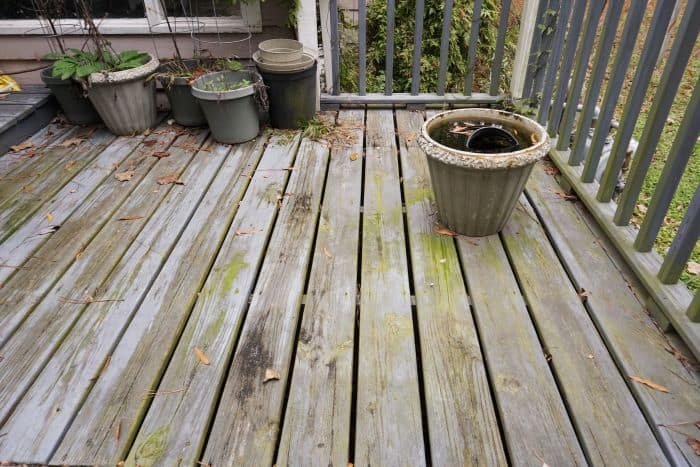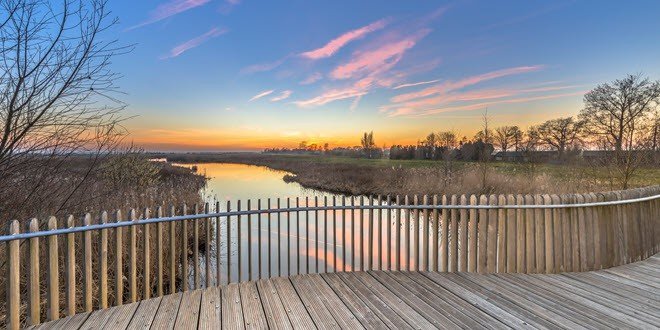What Deck Material Lasts Longest?
If you are looking to create a new deck, you are probably wondering what deck material will last the longest. There are so many choices out there that the task can seem daunting, and you want to make sure you are choosing correctly.
Cement decking will last the longest, with an average lifespan of 60+ years. It is durable and able to withstand the elements, making its higher cost worth it. Climate, type of cement used, and care of the cement will impact the decking’s lifespan.

You may still be wondering how to prolong your deck material’s life or what the next most robust deck material would be if you are not into cement. Aluminum and plastic lumber make for excellent second choices. Read on to learn more about cement and potential alternatives.
Table of Contents
Cement: Long Lasting Deck Material
When it comes to decking materials, cement is the longest-lasting deck material on the market. It is created to withstand the extreme weather ranging from storms to the bitter cold of winter, and nothing short of time or human excavation will wear it down.
If you are certain of your deck location and have no plans of moving it for the next 60 years, then cement decking is the perfect choice for you. You will be able to enjoy your deck in all its glory for decades to come.
Cement: Pros and Cons
Cement may be the longest-lasting deck material, but a long lifespan does not always equal a better decking material. Depending on where you live, your needs, and any other personal factors, you will decide whether or not cement is best for you.
Pros of Cement Decking:
- Longevity: Cement decking, when done correctly, can last up to 70+ years, giving it the most extended lifespan of any type of decking material.
- Versatile: Cement decking can be used in various ways, being poured into any type of mold to create a design.
- Easy Maintenance: Not requiring much work; cement decking is comfortable to take care of and clean.
- Cash value: Cement decking gives the consumer the most value for its price.
Cons of Cement Decking:
- Bland appearance: If you are looking for a more colorful or vibrant option, cement is not the option for you.
- High Upfront Cost: Cement decking costs a lot upfront but lasts the longest, making it a more long-term investment.
- Summer-time: If you live in a hot climate, or your deck will be in the sun most of the time, be sure to always be wearing shoes. Cement heats up fast and can reach temperatures of 135°F.
What Affects Cement Durability?
You will want to keep certain factors in mind when taking care of your cement decking to ensure that it lasts as long as possible. Cement is durable, but you can make sure it lasts even longer by keeping the following in mind.
Concrete Durability:
- Abrasion: Over time, concrete will begin to wear away, and this can be furthered by increased abrasion by other factors. The most common element in cement abrasion is materials being dragged across the cement often.
- Temperature Changes: Cement is very susceptible to temperature changes from freezing and thawing during winter. If the cement used is not resistant to freeze-thaw cycles, then the cement will begin to crack and erode quicker.
- Precipitation: Rain may not cause direct damage to cement, but it causes the steel rebars placed within cement to erode faster, damaging the structural integrity.
- Chemicals: Most cement is resistant to chemicals, but some substances can cause deterioration. Low permeability concrete is less likely to deteriorate from different chemicals.
How to Take Care of Cement
While cement is naturally a long-lasting, durable material, you can help your cement decking last much longer by performing some basic care for it. If you take the time to do these essential cement care tips, your decking will last much longer.
Cement Care Tips:
- Clean the cement at least once every year. Cleaning will help remove the dirt and grime on the cement, keeping your cement decking from turning gray and dingy.
- Repair any cracks that appear in your cement as quickly as possible. Repairing the cracks will keep water from getting into the cracks and causing deterioration of your decking.
- Make sure that the joints of your cement are sealed completely. Sealed joints will keep water and dirt from causing deterioration and prevent weeds from growing up through the joint cracks.
- Sealing the cement surface will help repel water, keep it from bleaching due to the sun, and help make it resistant to abrasion.
How Best to Clean Cement Decking
The best way to clean your cement decking is with a mixture of water and some other cleaning agent, typically vinegar, to keep chemicals off the cement. If you have a large cement slab that you are cleaning, you may find it best to use a mop to clean your cement.
The vinegar and water mixture will work well for mild to moderately soiled cement decks, but if your decking sees a lot of heavy traffic, it may be wise to consider a pressure washer. The pressure washer will get rid of the heavy grime stuck to the cement, and then you can use the vinegar-water mixture to finish the cleaning.
After cleaning your decking, if you have not already done so in the past, apply a sealer to the cement’s surface. You can easily apply it via a paint roller in a short period.
Choosing the Right Cement – Climate
Now that you have decided cement is the right material for your deck, you may wonder how you choose the proper cement. Different cement types are best for various projects, and your needs will decide what kind of cement you need personally.
The very first factor you should consider is the climate where you are currently living. Is it warmer or colder? Do you have harsh winters where you live? Do the summer temperatures reach high degrees?
If you live in a cold climate, you should consider purchasing high-early-strength cement as it sets much faster and will better stand up throughout the cold months. Conversely, if you are in a hot climate, it is recommended not to use the high-early-strength cement as it sets too quickly for proper finishing.
Choosing the Right Cement – Special Mixes
Once you have chosen a mix based on your climate, you may also want to consider several other unique combinations. The primary ones are crack-resistant mixes and air-entrained mixes, both of which help increase the lifespan of your cement.
Crack-resistant mixes contain special fibers that are woven into the cement itself. These mixes help prevent surface cracking, but if your slab is extensive or needs extra strength, crack-resistant cement should not be used to replace steel mesh or rebars.
Air-entrainment mixes are used to prevent the damage that comes from the freezing-thawing cycles of cold spells, making them useful for colder climates. You can get concrete bags with the air-entrainment additives already added to the mix.
Alternatives to Cement Decking
If you want a long-lasting decking material but do not wish to go with cement, check out the following durable options. Keep in mind these materials will require different care routines and are less long-lasting than cement.
Decking Materials:
- Aluminum/Steel: Steel is rated as the second most long-lasting deck material you can use, with an average lifespan of about 60+ years. Aluminum will only last about 30+ years. It is the most expensive option out there, though, and does require basic maintenance to ensure its longevity.
- Plastic Lumber: Plastic lumber lasts for about 30 years and only needs occasional cleaning as it is water-proof and will not rot. It costs around $5 – $9 a square foot, depending on where you live and where you purchase the decking.
- Composite Decking: Composite decking is on the low end of lifespan, having only about 25 years before needing to be replaced. It is low maintenance, however, and the decking boards are slip-resistant. It will cost you around $4 – $6 per square foot.
- Pressure-Treated Decking: This is your run-of-the-mill decking and thus only lasts around 15 years before needing to be replaced. It also requires the most maintenance out of all the options listed here, repainted or re-stained every 2 – 3 years. It will only cost you around $2 – $6 per square foot, however.
Conclusion
Finding the right decking can be challenging, but this article will have taught you everything you need to know to pick the suitable cement decking for your area and how to care for it properly. Be sure to checkout our article on whether or not a hot tub can go on decking, especially during the colder months.






